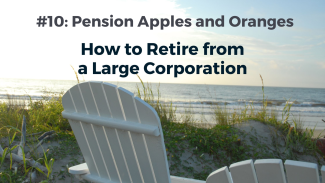
How to Retire from a Large Corporation #10: Pension Apples and Oranges
Are you like many people we know in Harrisonburg and Rockingham County who are excited about their retirement years, but are overwhelmed by the complexity and all of the numbers in front of you? When should you draw Social Security? How much will healthcare cost? How much will you actually spend in retirement?
All these numbers are important and you should absolutely get a handle on them as you get closer to the date; but do not get overwhelmed with the complexity of the task. The goal is to stay focused on the big picture and break down your decisions into simple action items.
This blog is the 10th in a series, “How to Retire from a Large Corporation” and is designed to accompany an e-book by the same name.
Are you fortunate enough to have a pension from your company? If so, then you should celebrate, because your children will probably not have the luxury of a pension when they retire. The next few blogs in this series were written to equip you to make the very best decision for you and your family.
Before we dig in, here is an important disclaimer required by our back office: A plan participant leaving an employer typically has four options (and may engage in a combination of these options), each choice offering advantages and disadvantages.:
- Leave the money in his/her former employer’s plan, if permitted;
- Roll over the assets to his/her new employer’s plan, if one is available and rollovers are permitted;
- Take a lifetime annuity check from company plan, if applicable
- Roll over to an IRA; or
- Cash out the account value.
Your pension may be one of your largest retirement assets. If you are like most folks we know in Harrisonburg, VA, and around the Shenandoah Valley, the pension decision can be the most difficult to plan around. Options abound, opinions are abundant, and you do not want to make a mistake with a decision this important.
In our prior posts, we explored the difference between lump sum rollovers and life annuity options. We also dug deeper into “leveling” and “PLOP” Options. We also walked you through how to determine the internal rate of return (IRR) you would need to earn on a hypothetical investment based on various life expectancies.
Now you have much of the data. But will you use it wisely to make the best decision for your family? All too often, soon-to-be retirees misinterpret the information or could be led astray.
Here’s an example: Let’s say you assume a life expectancy of age 85, and the IRR calculation shows that you need to earn 3% on a hypothetical lump sum investment to generate the same amount of income a life annuity pension would provide over your lifetime. So in other words, if you live past age 85, a hypothetical investment would need to generate a return greater than 3% for the lump sum to be a better option for you.
But read closely here. Don’t make the same mistake many people make. Often, when you run the numbers, an advisor may say something like, “The IRR on your pension is 3% to your life expectancy. We expect your investments to earn 7%, so you should definitely roll it over.”
For most retirees, this logic is an “apples to oranges” comparison and is faulty. Let me explain:
Many people in retirement who are taking income invest in a balanced portfolio with, say 60-70% in stocks and the rest in fixed income (bonds). The pension is a fixed asset, so you really cannot accurately compare a balanced portfolio to a fixed asset.
A more accurate comparison would be to compare the portion of your portfolio invested in bonds to the IRR of the pension. Do you expect the bond portion of your portfolio to earn more than 3% over your lifetime? Maybe, and maybe not. It is quite possible that the stock portion of your portfolio may average 7-9% per year over your lifetime, more or less, but quite possibly the bond portion will earn less.
Since the pension is a fixed asset, many retirees could benefit by taking the life annuity from their employer and then investing their IRA or 401(k) more aggressively. For instance, if you have $600,000 in your 401(k) and the lump sum pension is worth $400,000, you could invest all $600,000 of your 401(k) in stocks, take the lifetime pension, and still be considered a 60/40 balanced investor. Please consult your financial advisor before acting on any of the information presented here.
As you see, some of these decisions can be more complex than initially thought once you begin to dive into the details. Many other factors come into play when determining the pension strategy that is right for you, and the proper portfolio allocation.
Check back next time as we look into a pension strategy that could increase your monthly income, but also could pose more risk to your family. If you are fortunate enough to have a pension, then make the most of it!. To download the full “How to Retire from a Large Corporation” eBook you can find it here.
—-
This is the 10th of many blogs we are writing to help you finish strong in life. Much of the content is pulled from an eBook we wrote entitled “How to Retire from a Large Corporation.” Click here to download the document. If you would like to discuss any of these topics in more detail, you can schedule a time to talk through this link.

